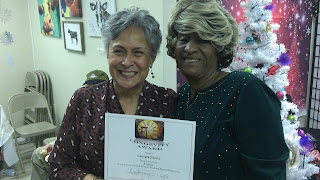Healthy Caregiving During the
Holidays
Many caregivers are perpetually tired from the
demands that result from caring for their loved one. Just the thought of your
normal routine plus decorating the house, attending special events, shopping
for gifts, and preparing special food for the holidays can be overwhelming.
But what if you had more control over the
events, expectations, and relationships that often make holiday times so
stressful? This could make a huge difference in the way you and your loved one
experience the season. It requires exercising some choices you may not be
accustomed to. Here are some suggestions to
help make this holiday season a joyous, healthful and manageable one for you
and your loved one.
Set realistic expectations for yourself and your loved
one
Take control of the
holidays by deciding what you and your loved one want. How many events, if any,
can you both attend or host without overdoing it? Who are the people you most
want to be with? What contributions are you capable of making in terms of food,
drink and gifts? These are basic questions that most caregivers don’t ask
themselves. Instead of making decisions that are in their best interest, many
wait for others to tell them where to go, what to bring, and so on. This year,
give yourself permission to say ‘no’ to unwanted demands.
Let others know when you need help
Caregivers typically try
to do everything themselves. But during the holidays there are often family and
friends around who are eager to help. If you want help, such as time away for
relaxation or an extra hand or two in the kitchen, don’t be afraid to ask. Not
only does this help you, but it can be very stimulating and enjoyable for your
loved one to have others to interact with and share in his or her care.
Express your emotions with family and friends
The holidays can trigger
emotions ranging from joy to depression in caregivers. A strong sense of loss
may work its way into your life during the holidays. It might involve coming to
grips with the permanent loss of your loved one’s mental or physical abilities.
Or perhaps you have a strong feeling that this may be your loved one’s last
holiday. Maybe it is the loss of your own freedom with caregiver
responsibilities that hits hardest during the holidays. Regardless, talk with
others about how you feel. By expressing your feelings with others you can
lighten your emotional burden.
Take time out for yourself
Everyone seems extra busy
during the holidays but for caregivers this can literally mean no rest from
morning to night. Start with the essentials: Get adequate sleep, eat well and
take time on most days for some physical activity. If possible, get out of the
house for brief periods to maintain perspective. Consider shopping online or by
catalogue for many of your gifts this holiday season. Then use the extra time
and energy you would have spent fighting traffic and standing in check-out
lines on taking better care of yourself.
Practice rituals that you and your loved one find
meaningful
Rituals are important ways
to add meaning to your holidays. Yet it’s very easy for the busyness of the
holidays to squeeze out any real meaning in the season. Practice rituals that
you and your loved one find meaningful, even if no one else is there to share
it. This might involve a favorite holiday meal, listening to a song together,
visiting a place with special memories for you both, etc. It can also involve
family and friends. And don’t be afraid to create new rituals as old ones may
have painful memories attached to them.
Celebrate what you and your loved one have right now
Caregiving often involves
the loss of things you want to hold onto, which can create a sense of
helplessness and anxiety. When we experience these emotions, it signals that we
are probably either mourning the past or worried about the future. But there is
little we can do about either—we can only address what’s happening in the
present moment. Celebrate what you and your loved one share right now, even
though it’s not what you might ultimately prefer. Try to let go of what was or
what could be and make the most of what you have.
It really boils
down to making choices. You only have a limited amount of time, energy and
resources available. The question is: How are you and your loved one going to
spend these? With a little planning and clear communication with friends or
family on your intentions, it’s possible to care for your loved one, take care
of yourself, and still take joy in celebrating the holidays.
By Gary Gilles, LCPC
Contributor,
mentalhealth.net
https://www.mentalhelp.net/blogs/healthy-caregiving-during-the-holidays/
Our Christmas Party video went up last weekend! Have you seen it? We had a ton of fun sharing stories, and playing various Christmas Games like Jingle Toss, Shake your Booty, and Dirty Santa! We also took time to recognize our Employee of the Year and every employee of the month for 2018.













